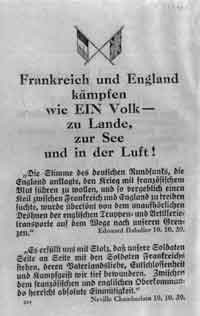
POLITICAL WARFARE EXECUTIVE
As an addition to the Central Intelligence Directorate, a Central Planning Section was established. This had the purpose of forward planning and weekly analysis of the quality of the propaganda and as the Director of Plans and Campaigns, P.W.E. appointed Ritchie Calder on 17th August, 1942. Working from 'the ducal china closet' of Woburn Abbey, a bed-sit in the village provided his off duty accommodation.

Being handled by the B.B.C., with it's own regional directors the general lines of policy were laid down by the central authority at weekly meetings supported by the regional information offices and with the central controllers of the European Service of the B.B.C. They were supported by representatives of the regional sections of the B.B.C. In fact the B.B.C. European Service maintained a marked degree of independence from both P.W.E. and Broadcasting House. Within this structure of general policy, considerable freedom was allowed to the P.W.E. Regional Directors and they worked closely with the corresponding regional sections of the B.B.C. Indeed - as recounted - towards this end they were housed in the same building. The regional directors of the Executive then submitted their weekly directives to Ivone Kirkpatrick for approval.
As for the actual propaganda produced by P.W.E., reliable means and mechanisms were essential to actually deliver these increasing amounts over enemy territory. One had sunk a German barge by plunging straight through the vessel whilst an unintended message from the heavens was delivered by another, which crashed right through the roof of Notre Dame cathedral. Conversely, even if they did disperse in the air those bundles intended for the Paris area, if scattered too early invariably ended up in North Africa and Turkey! In the early days few aircraft could be spared for dedicated leaflet drops and in fact, during 1941, the distribution of airborne propaganda to France was limited to Operational Training Units of the R.A.F., on 5 British stations. Indeed, since the R.A.F. were not keen on their postal duties at the end of 1941 P.W.E. was prompted to prepare a booklet for their benefit, setting out the achievements so far. This, however, received only a tepid reception, further cooled by Bomber Harris declaring that leaflets were just pieces of bumph. Nevertheless, late in 1941 No. 138 squadron had been formed at Tempsford for S.O.E. and S.I.S. operations and they sometimes assisted P.W.E., sharing such responsibilities with No. 161 squadron. As for one of the pilots, he acquired a locally inspired nickname by crashlanding his Lysander in Whipsnade Zoo. He thereafter became universally know as Whippy! Before other means of dissemination were developed, the aircrew involved in leaflet drops were definitely unenthusiastic about their role for, at least until April 1942, the arrangements for dropping their paper cargo involved the rear gunner leaving his position for several minutes, to unload the bundles. In hostile skies this left the aircraft dangerously vulnerable and of little surprise, over occupied France, in the first months of 1942 the average weekly air release of material, mainly Le Courier de LAir, was under 400,000, as compared with 2 million that P.W.E. required.
Leaflet bombs.
Then, in April, a proposal came for a specific P.W.E. squadron to be formed and although this did not occur, S.O.E. aircraft could sometimes be employed on special P.W.E. missions. Additionally, American help proved of especial benefit and throughout the war General Fred Anderson, deputy to General Spaatz, remained sympathetic to the P.W.E. needs, often providing aircraft for propaganda use. He also became involved with American experiments to produce a leaflet bomb and the dividends so reaped by it's perfection well justified the effort. Designed by Captain James Monroe, a laminated wax paper cylinder, 5 foot long and 18 inch in diameter, formed the structure of the first successful example, blown apart at a predetermined height of 1000 feet by a fuse. Thereby 80,000 leaflets could be released over a square mile. In fact the Special Leaflet Squadron had originally come to England in 1942 as a regular bomber squadron, the 422H of the 305th. Group but since April, 1944, began to work with Delmer's department as the Special Leaflet Squadron, having been exclusively assigned to leaflet dropping in October, 1943.

